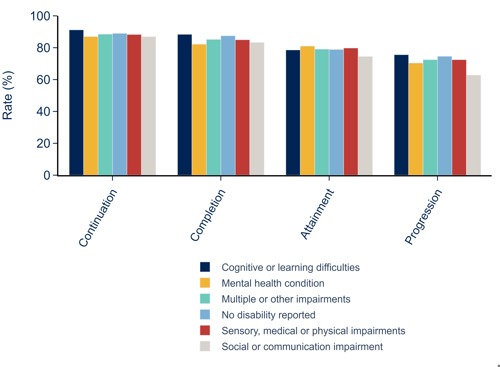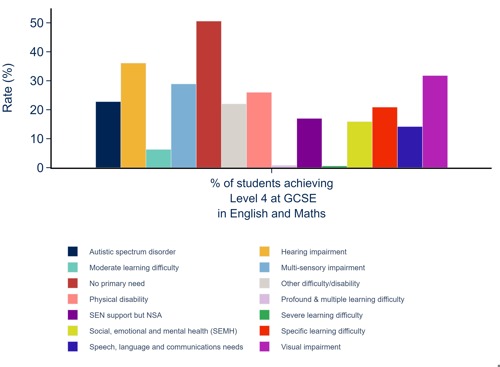Disabled students
This refers to students who have a disability.
Some data and studies use the Equalities Act 2010 definition of disability, while others use the term ‘students with a declared disability’: this does not necessarily align with the Equalities Act 2010.
Some datasets further define this (e.g. UCAS), but others do not. Other studies use the definition on the National Pupil Database of ‘disability’, which has seven distinct categories, and some also use special educational needs (SEN) or special educational needs and disabilities (SEND).
Some studies distinguish between categories of disability or special educational needs, but others use the broad category of ‘disabled’ or ‘SEND’.
Studies and datasets use a range of indicator, including two categories (e.g. disabled/not disabled) through to 11 categories (grouped by disability type).
Key statistics
On a provider level:
UCAS provide information on disability status. This is self-reported by the student. It can be matched to Individual Learner Records by a provider for internal database purposes.
The access and participation data dashboard has information on the access, continuation, completion, attainment and progression rates of students by disability (2-way and 6-way).
The student outcomes: Data dashboard has information on the continuation, completion and progression rates of students disability (2-way).
The sector distribution of student outcomes and experience measures data dashboard has information on the continuation, completion and progression rates of students by disability (2-way).
The size and shape of provision data dashboard has information on the profile of entrants by disability (6-way).
The TEF data dashboard has information on the continuation, completion and progression rates of students by disability (2-way).
On a national level:
The student characteristics data: Outcomes data dashboard has information on the profile, continuation, completion, attainment and progression rates of students by disability (2-way and 6-way).
The National Student Survey data: student characteristics data has information on the experience of students by disability (2-way).
Note: Definitions and the quality of each study vary.
Ashworth, E, Kirkby, J, Bray, L and Alghrani, A (2021) ‘The Impact of the COVID-19 Pandemic on the Education, Health and Social Care Provision for Children with Special Educational Needs and Disabilities (SEND): The Ask, Listen, Act Study.’ Evidence Briefing 1: Quantitative survey data. Discussion Paper. LJMU.
Chatzitheochari, Stella and Platt, Lucinda (2018) ‘Disability differentials in educational attainment in England: primary and secondary effects.’ British Journal of Sociology. ISSN 0007-1315
Department for Education (2023) ‘HE providers’ policies and practices to support student mental health’ (publishing.service.gov.uk) (Accessed 12/12/2023)
Department for Education (2023) ‘Special educational needs and disability: an analysis and summary of data sources June 2023’. (Accessed 12/01/2024)
Department for Education and IFF Research (2019). ‘Evaluation of disabled students’ allowances. January 2019’. (Accessed on 15/12/2023)
HEPI (2023) ‘Student Academic Experience Survey 2023’. HEPI. (Accessed 12/12/2023)
Kendall, LS (2016) ‘Higher education and disability: Exploring student experiences’. Cogent Education, 3. ISSN 2331-186X
Leonard Cheshire, ‘Reimagining the workplace: disability and inclusive employment.’ February 2019. (Accessed 11/01/2024)
Office for Students (2023) ‘Insight brief 19. Protecting students as consumers’.
Paterson, J., McCarthy, M. & Triantafyllopoulou, P. (2024) ‘The impact of the coronavirus pandemic on the lives of children and young people who have special educational needs and/or disabilities in the UK: A scoping review’. Journal of Research in Special Educational Needs, 24, 12–24. Available from: https://doi.org/10.1111/1471-3802.12608
Policy Connect (2020) ‘Arriving At Thriving: Learning from disabled students to ensure access for all’. (Accessed 12/12/23)
Russell Group Students Union (2023) ‘Cost of living report’. (Accessed 11/01/2024)
Schuelke, L., Munford, L. & Morciano, M. (2022) ‘Estimating the additional costs of living with a disability in the United Kingdom between 2013 and 2016’. Eur J Health Econ 23, 313–327 (2022). https://doi.org/10.1007/s10198-021-01366-1
TASO (2023) ‘Rapid review to support development of the Equality of Opportunity Risk Register’. (Accessed 12/01/2024)
The Association of Graduate Careers Advisory Services (2019). ‘What happens next? 2019’. September 2019. (Accessed 12/12/2023)
UCAS ‘Next Steps: What is the experience of disabled students in education?’. (Accessed 11/01/2024)
Veruete-McKay, L., Scheulke, L., Davy, C., & Moss, C., (2023) ‘The disability Price tag: Technical report 2023’. Scope. (Accessed 01/12/2023)
WONKHE and Pearson (2022) ‘Students' perceptions of belonging and inclusion at university’. (Accessed 12/12/2023)
Describe your experience of using this website


